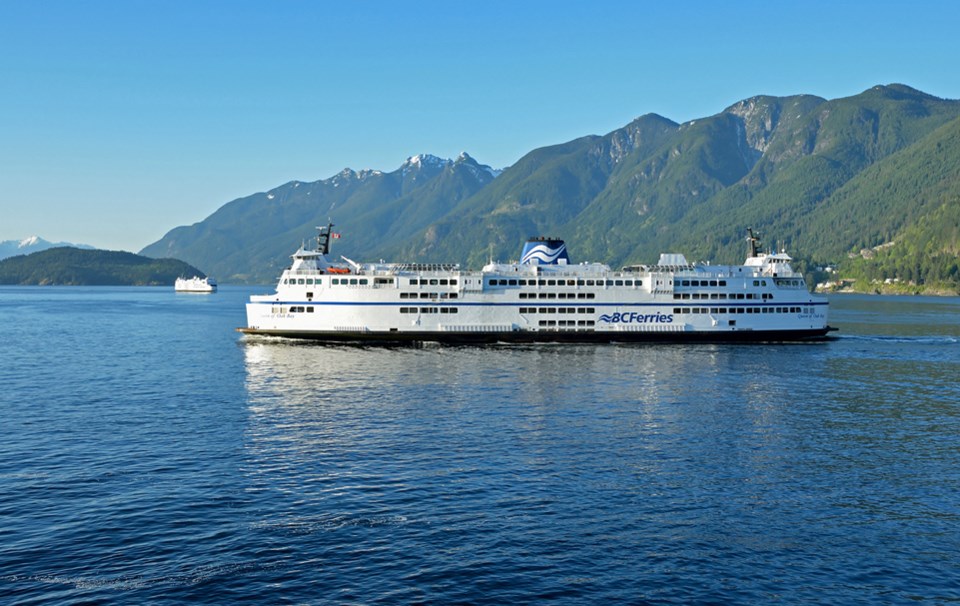BC Ferries says the target date for two-vessel service on the Langdale-Horseshoe Bay route is 2024, when the Queen of Oak Bay will be available all year.
Adding a second, full-time vessel and the terminal upgrades at Langdale and Horseshoe Bay were among the major topics at the June 6 meeting of the Southern Sunshine Coast Ferry Advisory Committee (FAC) in Sechelt.
When asked in recent months, BC Ferries officials have typically given a timeline of about five years for the addition of a second ferry and pointed out that it’s dependent on terminal upgrades and the purchase of new ships.
“The timeframe for those, particularly Horseshoe Bay, seems to be longer than that five-year timeframe,” FAC chair Diana Mumford said. “Our question is, what are the plans to deal with the traffic [in the meantime], because there is a significant increase in traffic each year.”
According to BC Ferries, the Langdale terminal upgrade is on track to finish in 2022, and the overhead walkway for foot passengers is the priority project. It should be in place by next year. For Horseshoe Bay, the company is still in the planning process and construction should begin in 2023 or 2024.
But, BC Ferries officials at the meeting also said the timing of a change to two-vessel service is less dependent on those construction projects than it is on when Ferries can take delivery of a new vessel to serve Vancouver Island.
That should happen during the latter part of the company’s 2024 fiscal year, at which time the Queen of Oak Bay can be reassigned.
Peter Simpson, director of fleet operations strategy with BC Ferries, said two-vessel service would start with the Queen of Surrey running in tandem with the Queen of Oak Bay.
“We’re planning for it to be the Surrey and the Oak Bay, and then when they retire they’ll be replaced by two new ships… The Oak Bay and Surrey will be dedicated to this route [in the meantime].”
The new ships – which BC Ferries refers to in planning documents as “New Major #6” and “New Major #7” – are expected to be ready sometime in fiscal 2030.
The keen public interest in two-vessel service is being driven by frustration with delays and overloads which seem to be getting worse every year.
The expanded sailing day, with larger gaps between sailings and a late-night trip from Horseshoe Bay, was supposed to address the problem and according to BC Ferries’ numbers, it seems to be helping – at least with on-time performance.
On-time performance [OTP] on Route 3 improved from 70 per cent in April 2017 to 84 per cent this April and from 59 per cent in May 2017 to 76 per cent this May.
However, the number of overloads increased by 234 between the fiscal year that ended March 31, 2017 and the one that ended March 31, 2018.
“Seventy-six per cent [OTP in May] is still below our targets for the route,” Simpson said. “But it’s an improvement… May had some challenges, in terms of increased traffic. [The year-to-year increase] looks to be in the two to three per cent range. That’s two to three per cent over the entire month… If all that traffic concentrates between Fridays and Sundays, it can be more. If it concentrates between three o’clock and six o’clock on a Friday, that can be a big hit on the system.”
Mumford said that’s exactly what seems to be happening during the so-called shoulder season. “We have very cyclical and directional traffic and it’s Fridays and now it’s sort of easing into Thursdays and Sundays into Mondays, and on a long weekend it moves one more day,” said Mumford, adding that when you average traffic numbers over the month, the figures don’t address those peaks.
“Pretty well every time I’ve gone to the ferry in the last few weeks it’s an overload… Friday is scary at Horseshoe Bay,” she said. “I think that’s where the frustration from the community is. We get that it’s only increased three per cent or four per cent, but it’s increasing at very restricted times and I guess we’re looking for more options than [a second ship] five years down the road.”



